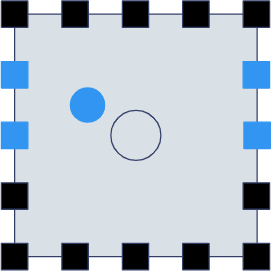Cavern Driver user guide
Environment

The environment type determines how the layout should be aligned and what renderer should be used. There is an environment for all use cases.
- Studio: For a single listener in the center with speakers placed around in a sphere. This symbolizes the best acoustic environment where hardly any renderer correction is required.
- Home: For a single listener or a few listeners close to each other on the center with speakers placed close to or on the walls. This environment fits most rooms.
- Theatre: For many listeners. Viewers at the sides or the back of the room will also experience 3D audio, unlike in Studio or Home environments, but this will reduce the overall effect quality, even on the center.
Rendereres used
The exact renderer used depends on the environment and whether the channel layout is symmetric or not.
| Environment | Symmetric | Asymmetric |
|---|---|---|
| Studio | Balance-based | Hybrid directional |
| Home | Balance-based | Hybrid distance-based |
| Theatre | Balance-based | Directional |
How renderers work
This is a short summary of renderers. For an exhaustive description, read this article.
Balance-based renderer

Point object sources are rendered in a bounding speaker box by the ratio between them. This is the most common rendering method, used by all major commercial formats. The only disadvantage would be the need to have matching layers or edge cases, but Cavern handles each layer separately, and only vertical symmetry is required.
Distance-based renderer

Point object sources are rendered to all channels, and their gain is determined by distance. This is a solution that can apply to any system and has perfectly smooth transitions, but even when a source is standing perfectly on a single channel, close speakers will also render the sound, which reduces the soundstage. The renderer can't be used for large multi-listener environments, as gain proportions are only correct close to the center.
This is only an advertisement and keeps Cavern free.
Directional renderer

A renderer that works with every layout and has an accurate soundstage, but no in-room panning and limited object size capabilities. This is a good compromise for large asymmetric multi-listener environments.
Hybrid renderers
Hybrid rendering mixes the directional and distance-based renderers to keep most of their pros and suppress their cons. Hybrid directional is mostly directional, while Hybrid distance-based is mostly distance-based.
Environment size

There's a slider for room width, height, and depth. This is only used by the object renderer, and is not applicable to pre-rendered beds (like movies), 2D objects (like background music), Unity's audio engine, or QuickEQ.
Symmetry

Feedback about what renderer is being used. The toggle for forced symmetry makes one side of the room mirror the changes on the other. Enabling forced symmetry for an asymmetric layout immediately converts the layout to symmetric, close to the current one.